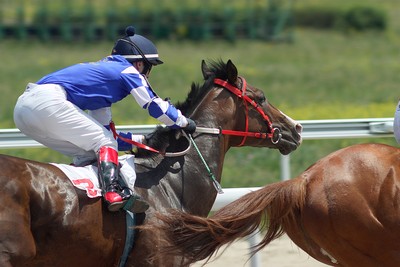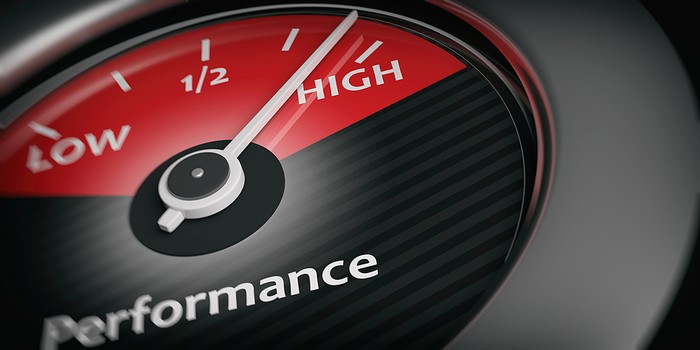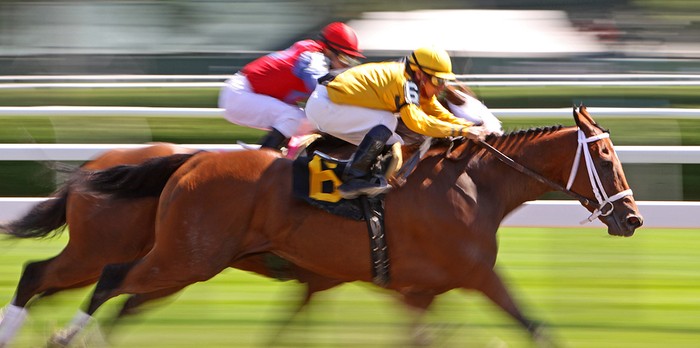 If you look at the result of a horse race you will find out which horse has won a given race, but also their margin of victory over the second-place finisher.
If you look at the result of a horse race you will find out which horse has won a given race, but also their margin of victory over the second-place finisher.
Usually this margin of victory – or winning distance – is given in “lengths”. But what exactly is a length in horse racing? Or, to put it another way, how long is a length?
What is a Length?
According to the British Horseracing Authority, “A length is a measurement of elapsed time as the horses cross the line and can vary on the size of the horse and its stride pattern, but in general would be about 8 to 9 feet.”
When Is A Length A Measurement Of Time?
 Whilst a “length” essentially means the approximate length of a horse from nose to tail, it is a term that is used in quite a broad fashion. So, unlike most units of length, the “length of a length” does not appear to be defined in a concrete manner. If we look to something like a metre, for instance, there is a set and agreed definition (namely, the length of the path travelled by light in vacuum during a time interval with duration of 1/299 792 458 of a second … but we’re sure you knew that!). However, with the length of a length in horse racing, the primary governing body of UK horse racing is saying that a length can vary depending on the size of the horses!
Whilst a “length” essentially means the approximate length of a horse from nose to tail, it is a term that is used in quite a broad fashion. So, unlike most units of length, the “length of a length” does not appear to be defined in a concrete manner. If we look to something like a metre, for instance, there is a set and agreed definition (namely, the length of the path travelled by light in vacuum during a time interval with duration of 1/299 792 458 of a second … but we’re sure you knew that!). However, with the length of a length in horse racing, the primary governing body of UK horse racing is saying that a length can vary depending on the size of the horses!
To make matters even more confusing, as mentioned, a length is a “measurement of elapsed time” rather than a specific measurement of the distance between the horses. So how does that work? Well, for races in the UK at least, the race judge calculates the distances between the winning horse and the other horses based on the time between each crossing the finish line. This time is then converted into lengths using the Lengths per Second Scale (Lps). Given that thoroughbred horses are pretty darn fast creatures, they can travel up to around six lengths per second. But in order to give an accurate assessment of the winning distances, the Lengths per Second Scale is altered slightly based on the type of race, surface and how quick the going is.
Based on the British Horseracing Authority’s guidance on the Lengths per Second Scale which was effective from May 2016, the following Lps ratings apply to the following types of races/conditions:
Flat Turf Races
| Going | LPS Rating |
|---|---|
| Good or quicker | 6 |
| Good, good to soft in places | 5.5 |
| Good to soft, good in places | 5.5 |
| Good to soft | 5.5 |
| Good to soft, soft in places | 5.5 |
| Soft, good to soft in places | 5 |
| Soft or slower | 5 |
National Hunt (Jumps) Turf Races
| Going | LPS Rating |
|---|---|
| Good or quicker | 5 |
| Good, good to soft in places | 4.5 |
| Good to soft, good in places | 4.5 |
| Good to soft | 4.5 |
| Good to soft, soft in places | 4.5 |
| Soft, good to soft in places | 4 |
| Soft or slower | 4 |
Flat All Weather Races
| Course (Going) | LPS Rating |
|---|---|
| Kempton Park (Standard) | 6 |
| Lingfield Park (Standard) | 6 |
| Wolverhampton (Standard) | 6 |
| Chelmsford City (Standard) | 6 |
| Newcastle (Standard) | 6 |
| Southwell (Standard) | 5 |
National Hunt Flat All-Weather Races
| Course (Going) | LPS Rating |
|---|---|
| Kempton Park (Standard) | 5 |
| Lingfield Park (Standard) | 5 |
| Newcastle (Standard) | 5 |
As you can see, the number of lengths per second varies significantly between, for instance, a flat race on good ground compared to a jumps race on soft ground. But this is a reflection of the relative speed of the horses running those respective contests. And though the actual “length” of a length is not going to come down to an exact science, this system at least offers a good level of consistency across horse racing in the UK.
Why Are Winning Distances Important?

The reason it is important to have a consistent system in place to assess the winning distances and distances between horses in any given race is that these distances are used by handicappers to assign official ratings to runners. This in turn allows handicappers to assign weights to runners in handicap events and if there were big inconsistencies in how distances between horses were measured, the already tricky task of assigning ratings and weights that are fair (or as fair as can be expected) would become an almost impossible task.
The details of how ratings and handicaps are calculated are beyond the scope of this article, but has been covered here.
What Are The Winning Distances In A Horse Race?

In horse racing results you might see a horse listed as having won by 14 lengths (14L), three and a half lengths (3½L), or even half a length (½L). But sometimes races are won by margins of less than half a length, in which case the following winning distances might apply.
- Neck (nk) – A distance of less than half a length and could be around a quarter or a third (no official definition exists) that is roughly equivalent to the length of a race horse’s neck.
- Head (hd) – Again there is no exact figure for the length of a head, but it corresponds, as one might expect, to the rough length of a horse’s head. So if, for example, a photo finish shows the winning horse to have won by the length of their head, they would be deemed to have won by a head.
- Short Head (sh) – A short head is somewhere between a head and a nose and is roughly a 10th of a length, though again this is not exact.
- Nose (nse) – This is the smallest winning distance possible in a horse race and applies when one horse is deemed to have just edged ahead of another (or others) at the finish. In case you needed to know, it needs to be the actual nose of the horse finishing first, the tongue or ears do not count (according to the BHA’s rules of racing).
- Dead heat (dh) – This occurs when two (or more) horses cannot be separated by a photo finish and are thus deemed to have finished at the same time. Note that in such a scenario, dead heat rules would apply to any bets placed on the horses that finished at the same time, which would reduce the amount of your stake that counts towards the winning bet, thus reducing your winnings.
A Useful Rule of Thumb

As you can see, when it comes to lengths and other winning margins in horse racing, things are far from exact. But then it’s not like the organisers are trying to land a spaceship on Mars or performing neurosurgery, so it’s not as though perfect accuracy is a necessity. The fact that, in the UK, there is a system in place that means winning margins and lengths are understood by all parties is important. And though the actual length of a length can vary slightly, if you think of it as roughly the length of the winning horse from its nose to its tail, you won’t be far off.
